I Broke My Bed – Character Developed
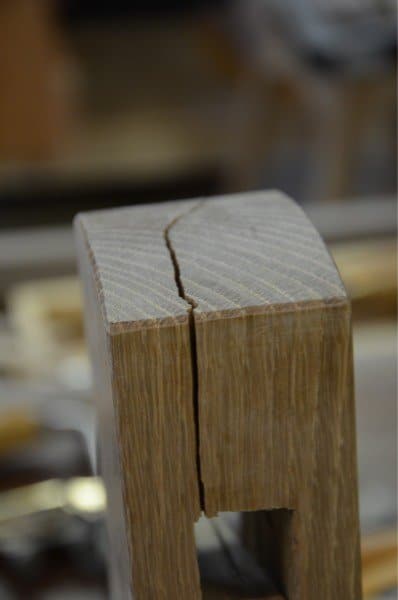
Ever had one of those last minute failure when wood splits in the middle of glue up or you miscalculated something that almost ruined your project. Yesterday I was putting my bed head together and suddenly the top of the bed post just popped. It was a no-way-back moment even though I had rehearsed the assembly four times during joint testing and so on. Here at the Castle is a major collection of art work and furnishings not the least of which is a Rembrandt worth £60m. The property is well protected and my workshop falls within the parameters of set alarm times and locked doors that are beyond my control. I had only a few minutes to reverse my work and was thankful I knew exactly what I must do, even though it seemed so impossible. With straps and ratchets I manages to separate the offending component and found the source of the problem beyond that. One wrongly located piece had twisted the whole and caused the undue stress. I missed it and in my efforts to seat the joint the post split. I had to then dismantle 42 mortise and tenon joints to make one minor yet major change.

I don’t get dispirited very often, but here I was, constrained to make right the wrong that, had the ticking clock been more lenient, I could have fixed in a few minutes. Alas, I had to leave.
Today, I returned to the scene of the crime. The errant post stood sadly in the corner and the crack very self-evident. I learned not to cry over such issues when I started work at 15. Things go wrong and you have to deal with them.
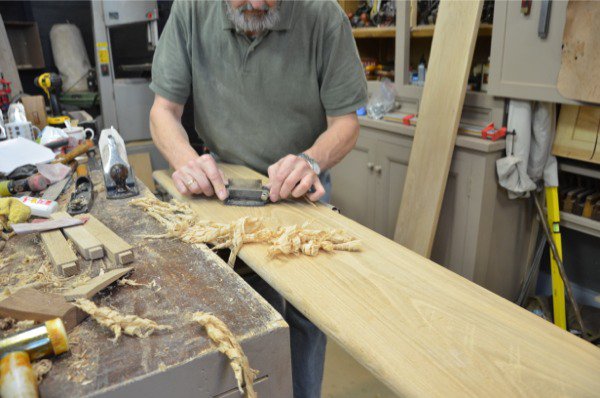
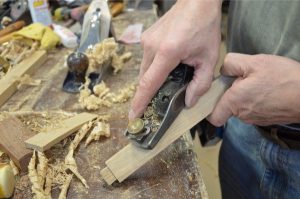
In this case I new to correct the wrong was not complex. What was more difficult for me was the self examination of whys and wherefores. All the parts were numbered correctly and in order. The problem was simple to see, but what was difficult to accept was that in the smallest failures there is almost always a knock-on domino collapse we don’t see the significance of. The work did bother me, but it caused me to reflect on life itself. Sometimes we make small decisions without realising others are affected by what we did or did not do. In my experience it’s always good to go back to the point where something went wrong and there you almost always find the answer that somehow doesn’t let you off the hook but helps you better understand that there are consequences to what happened.
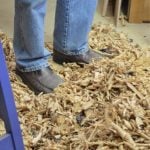
The dismantled parts had small but relevant tell-tale signs I could retrace forensically to regain myself. Soon I saw that one piece was irreversibly misplaced. Had I not failed on the one hand, the misplaced piece would have been facing the wrong way. I mean this was one of three of the inlaid panels central to the whole bed facing the wall.I was glad for the mistake today as I refitted and reassembled the components for an absolute final rehearsal.
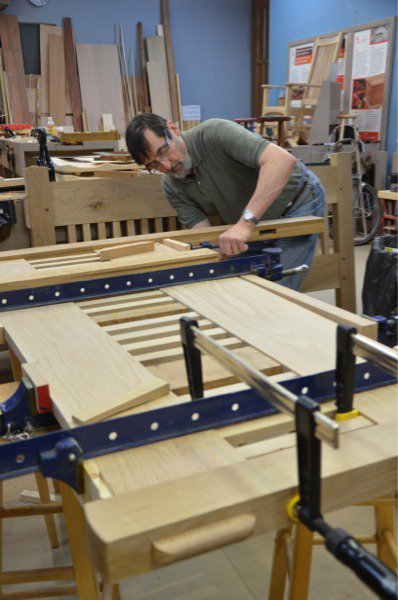
I don’t see everything and neither do I understand everything, but one thing I know is that woodworking is a totally reductive process for any craftsman. It’s a refining process whereby opinions and experience often need dismantling so that we can take a different perspective, change direction and absorb some painful things to refine and define who we are and what we are.


I feel sorry for you, but on the other hand it’s good to see someone with your experience can still make errors like this. This encourages people that have just started woodworking not to give up when things go wrong.
Life is not about the errors you make but about how you deal with them and what you learn from them.
Thank you for sharing this with us!
Paul,
Merry Christmas first of all. I am sorry to hear what happened. Take it easy. Certainly much worst things can happened. As why it happened? Doesn’t matter – remember – any failure is an opportunity in disguise.
My sentiments entirely, Reinoud. It’s seeing these errors that gives us all the feeling we aren’t the only ones!
Paul, I’m fairly sure I have read in Hayward never to make a mortice over a third of the total width of the stuff, could this be partly to blame as well as the twisting stresses?
Lovely project though.
Gary
Good thought, but, no. I tracked it down and know what went wrong. After the initial disappointment I enjoyed the reconciliation part that followed. Almost there now.
The only man who never makes a mistake is the man who never does anything.
-Teddy Roosevelt
Paul I am sorry to hear about the mishap and setback but fortunately you were able to find the problem and find a remedy for it fairly quickly. I on the other hand was not so lucky yesterday.
Our Daughter gave me an old bookcase that belonged to our Grandson ( “Thomas the Train” theme ) who out grew it. It had ( 2 ) sides with ( 3 ) 3/4″ dowels on the front and ( 3 ) slats on the back other wise it was open both front and back. I had it sitting on the floor in my shop and I actually used it to store my hand saws which worked quite well. And being frugal at times and recycling things I thought after painting it would be great.
I was waiting for some glue to set so I thought this would be a good time to take it apart and paint it to match my bench. I have a nice spot to hang it on my wall and would look good and get this off the floor. Well the problem started once I started to put it back together I was going to glue and screw everything everything where it belonged. Well I guess I over torqued the screws because the slats split and could not be used. This case was actually made out of MDF which I detest but thought why not try and use it.
So I am back to square one and will buy some 1 X 12 pine for the sides and put a proper back on it to make it right.
I guess everyone has those day’s occasionally.
Thanks for sharing this Paul.
Steve
Dear Mr. Sellers – in my small opinion, this is perhaps the best web log entry you have ever shared with the wood working community and I salute you for it. Your words are poetic, reflective, vulnerable, brave as Oak, too.
“but what was difficult to accept was that in the smallest failures there is almost always a knock-on domino collapse we don’t see the significance of.”
How can any person whose taken some risk in life not relate to this?
I get weepy sometimes at all my own mistakes, too. and wish I could give you a big bear hug ‘because we’re all cheering for you from a long way out. I also find comfort in knowing sometimes it’s the “mistakes” that make a piece special. So I ask: is there anyway to salvage the bed post? Can you reglue the split post?
-Adam of Oakland, CA, USA
Often long grain to long grain repairs will work fine. My worries have always been this. What happens if for some reason the repair were to fail down the road? Would my customer feel let down when he or she finds a fractured leg or post had be repaired? Bit like biting into a rotten apple.
The world would be a boring place if everything was the same and we never made mistakes.
I think your inspirational sentence ” It’s a refining process whereby opinions and experience often need dismantling so that we can take a different perspective, change direction and absorb some painful things to refine and define who we are and what we are.” is a definition of life itself. Thank you Paul
Being self employed I feel the same worries of field failures damaging my reputation. I always evaluate between function, conscience and the consumer expectation which sometimes means losing money on projects. – my conscience usually decides.
Just curious what your response is if the repair were to fail down the road?
I was saying that in general I will replace a part rather than glue, unless I am certain there is no chance of further failure. A repair is very expensive if it’s down to the craftsman a half day’s drive away to pick up a piece for repair he has to eat. Also, things like chair parts are always replaced and not glued. I couldn’t live with myself if someone was injured because of failed repair.
Paul- Suppose you decided to remake this part. Normally, we chop the mortise, we get what we get, and then we fine tune the tenon. In this case, the tenon is already done, so if you make a replacement post, how would you tune the joint? Patient paring of the mortise? Does that work, especially in a heavy component like this post? If it weren’t a through tenon, you could glue shims onto the tenon and tune as normal, but wouldn’t’ that show on a through tenon.
I feel your pain,Paul. 25 years ago my first woodworking project was an oa dining room set. Everything had been done with handtools on the balcony of my apartment. A few weeks after finishing two of the chairs I listenened to the joints blow apart from being too tight.
Nice recovery on your part. Best wishes to you, Paul.
I enjoy your way of teaching. It’s very pleasent beeing thaught, in this simple and honest way!
When a master embrasses “this kind of steps” and share them with his aprentices, the path for technical and personal development gets wider and inlight.
Thank you! for sharing.
This is the first time I thought I had something of relivence to comment on. Apon reading other comments, I see that my thoughts have been covered. Thank you Paul for share
ing all you aspects of craftsmanship and life’s pholosophys. cheers Peter appologies for spelling errors.
So sorry to hear of this, but on the plus side you learned something. When I owned a manufacturing business and things would go wrong, we would not rest until we found the Root Cause of the occurrence. I made sure everyone in our small shop of 20 people was involved in the investigation so everyone could develop both their investigative skills and awareness of how seemingly small things can result in a catastrophic event. We seldom if ever repeated the same mistake.
Don’t you just hate it when that happens, Paul so sorry to hear that, as you say you learn not to get upset about mishaps when you start working in wood from day one- but it hurts when your project makes a turn for the worst.
Well, if it had to happen, thank goodness it happened in a dry assembly rather than during glue-up, especially so close to having to vacate for the day with no chance to stay late. Through tenons are so tough for me. Everything shows without a shoulder, so you go for tight, but then the more you try for perfection, the closer you are to disaster. Paul, you once said that taking risks was important in woodworking. Perhaps if these things don’t happen now and then it means you’re not taking enough risk?
Really thank you for sharing this, you are a true “maestro”.
Adapt and overcome that’s what I say. Good job I am sure it looks great.